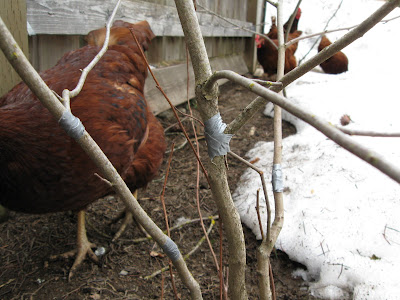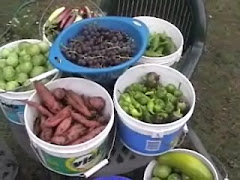I love potatoes, not just any potato...all potatoes and that is why we will be growing twenty five varieties this year. Last year I think we had around twenty and maybe 45 plants. I think that growing ones own food is very important, but just as important is
enjoying growing ones own food and variety allows for that.

There are many reasons that I grow a large number of each type of vegetable aside from the enjoyment aspect. It allows me to see which vegetables do best in my garden and in any given condition that may arise, and also provides me with the opportunity to be more self-reliant. More self-reliant in the sense that I am able to save seeds from a much wider selection of crops and will eventually, I hope, be able to rely more upon myself for those seeds and less upon others (seed companies).
Now that I have attempted to justify why anyone in their right mind would possibly choose to grow twenty five different varieties of potatoes, here is what we will be growing for ourselves and our chickens :). Many of these potatoes will be grown from my own seed but I did purchase a few of them.
Purple Majesty - One of our favorites, it is purple inside and out. We are sometimes provided with really large specimens that taste great fried, baked or boiled and are most wonderful tossed hot over a healthy green salad.
 Red Lasoda
Red Lasoda - Red skin and white flesh makes for a great potato salad. We do have a problem with scab on this one in particular...but hey, scab is only skin deep and who will ever know if you mash it.
 Yellow Finn
Yellow Finn - New to us this year, it is supposed to have yellow flesh with a buttery flavor and be a good keeper. A butter like flavor...why is it that every yellow fleshed potato seems to be described that way? I have yet to eat a butter flavored potato, but I am sure this will be the first.
 Sangre
Sangre - The name means "blood" in Spanish, it has a dark red skin with white flesh, nice used as a new potato. We are always
stealing this one in July as it seems to come on fairly early and gives us lots of baby potatoes.

Mountain Rose - A sometimes large potato with red skin and pink flesh it makes for a great boiled potato.
 Dakota Pearl
Dakota Pearl - We first grew this last year and really liked it. The potato has an almost white skin and flesh, very crisp potato that takes extra time to cook. Small to medium in size all of mine were free of defects such as scab. A fine choice for hash browns.
 Huckleberry
Huckleberry - Red skin, pink inside (especially once cooked) with some white, very similar to Mountain Rose. My wife is partial to this one and always chooses it to top her salads. Grows really well for us and is named after huckleberries that grow wild here in the northwest.
 Gold Rush
Gold Rush - We are trying this one for the first time this year. Supposedly a nice baking potato with good flavor it is a cross between a Lemhi Russet and Norgold...supposed to do well in dry climates.

Russet Burbank - Most widely grown potato in the United States. A favorite for baked potatoes especially in Idaho. The chickens love them and they are regularly included in their diet. Ours always turn out short and fat and bear little resemblance to the perfect store bought russets.

All Blue - Medium sized potato with blue/purple skin and a bluish interior. A bit of a mealy potato I have grown to love after becoming accustomed to the texture. Very high yields for us.
 Russian Banana
Russian Banana - With yellow skin and flesh this potato makes for a great french fry and also seems to grow well in our climate putting out numerous disease free tubers.
 Swedish Peanut
Swedish Peanut - Another potato that we are trying for the first time, I hear it has a nutty tasting yellow flesh and should be good in a stir fry as it is supposed to stay firm when cooked.
 French Fingerling
French Fingerling - A staple in our diet, the french fingerling has red skin and slightly yellow flesh with a red line running through the middle. Another potato that does well fried.

LaRatte - We have yet to try this yellow skinned potato that reportedly has a creamy yellow flesh and somewhat nutty flavor.
 Austrian Crescent
Austrian Crescent - With light yellow skin and flesh this potato, along with all of the other fingerlings, is really a treat when steamed and served on it's own.
 Anna Cheeka Ozette
Anna Cheeka Ozette - A very interesting looking potato with deeply set eyes, yellow skin and flesh. This potato stores and produces very well for us.

Red Thumb - With red skin and flesh we were not able to find this potato last year and are excited to grow it this summer. It is supposed to be very uniform in shape and have a nice texture and flavor.
 Adora
Adora - Very productive with yellow flesh and round shape. Makes a fine boiled potato, especially when young.

Red Norland - Red skin and almost white flesh, perfect for potato salad. Does seem to have an issue with scab.
 Norkotah Russet
Norkotah Russet - Like the Burbank russet, a nice baking potato that produces fairly well...but not great. Some of these get really big.

Yukon Gold - Thin skin and yellow flesh, definitely my favorite baking or boiling potato. Unfortunately it does not produce all that well for us.
 Red Pontiac
Red Pontiac - Large round potato with thin red skin and white flesh this potato is perfect for mashing.
 Purple Viking
Purple Viking - Purple skin and white flesh, it will be a first for us as well.

Superior - White fleshed potato that is an all around excellent potato and supposed to be good for making chips, although we have never done so.
 Purple Peruvian - Our favorite finger potato with purple, almost black skin and a dark purple flesh. Mealy but delicious, they almost grow wild around my garden as they have so many eyes that even the smallest piece left in the ground produces a plant.
Purple Peruvian - Our favorite finger potato with purple, almost black skin and a dark purple flesh. Mealy but delicious, they almost grow wild around my garden as they have so many eyes that even the smallest piece left in the ground produces a plant.

Lots of potatoes, yes, but as a staple in our diet and that of our chickens we go through them pretty fast. No matter how many potatoes we grow the best ones are those that end up on a salad at the end of the day.







































 Purple Peruvian - Our favorite finger potato with purple, almost black skin and a dark purple flesh. Mealy but delicious, they almost grow wild around my garden as they have so many eyes that even the smallest piece left in the ground produces a plant.
Purple Peruvian - Our favorite finger potato with purple, almost black skin and a dark purple flesh. Mealy but delicious, they almost grow wild around my garden as they have so many eyes that even the smallest piece left in the ground produces a plant. 










 This fits nicely over my 4' wide rows as well. The hoops are held at ground level with 12" wood stakes that are cut from the many maple saplings that grow on our property.
This fits nicely over my 4' wide rows as well. The hoops are held at ground level with 12" wood stakes that are cut from the many maple saplings that grow on our property. The stakes are pounded at an slight angle about 6" into the ground and the poly pipe fits snugly over them.
The stakes are pounded at an slight angle about 6" into the ground and the poly pipe fits snugly over them.
 Normally the hoops are placed 3' apart all down the row. Going forward I will be placing the hoops every 2' as we have had record snowfall the last couple years and more support is needed. At 3' apart the hoops will easily hold up to 2' of dry snow or a little over 1' of heavy wet snow before they are compromised.
Normally the hoops are placed 3' apart all down the row. Going forward I will be placing the hoops every 2' as we have had record snowfall the last couple years and more support is needed. At 3' apart the hoops will easily hold up to 2' of dry snow or a little over 1' of heavy wet snow before they are compromised.


 A 5-6' long pole with a natural V shaped notch or one that I have cut is then placed at the end of each row to further stabilize the entire structure.
A 5-6' long pole with a natural V shaped notch or one that I have cut is then placed at the end of each row to further stabilize the entire structure.



 To further strengthen the pipes a piece of rope or twine can be attached to both sides of each hoop in order to allow it to handle more downward pressure.
To further strengthen the pipes a piece of rope or twine can be attached to both sides of each hoop in order to allow it to handle more downward pressure. Neither the ropes or end poles are necessary if snow is not an issue. I use 10' wide clear plastic sheeting as that allows for an extra 1' on each side of the row that can be held down with brick, rocks, or wood. In the winter I just use the snow to my advantage as the other weights often become frozen to the plastic.
Neither the ropes or end poles are necessary if snow is not an issue. I use 10' wide clear plastic sheeting as that allows for an extra 1' on each side of the row that can be held down with brick, rocks, or wood. In the winter I just use the snow to my advantage as the other weights often become frozen to the plastic. The plastic is cut lengthwise so that it overhangs each end of the row enough to be held down with another weight.
The plastic is cut lengthwise so that it overhangs each end of the row enough to be held down with another weight.
 One of the biggest problems is the plastic freezing to the ground, my only solution to this is to patiently wait until a warm day allows for the removal of frozen ice and snow. Lastly, the plastic sheeting can be blown off when the wind catches it if not held down in enough places.
One of the biggest problems is the plastic freezing to the ground, my only solution to this is to patiently wait until a warm day allows for the removal of frozen ice and snow. Lastly, the plastic sheeting can be blown off when the wind catches it if not held down in enough places.




















